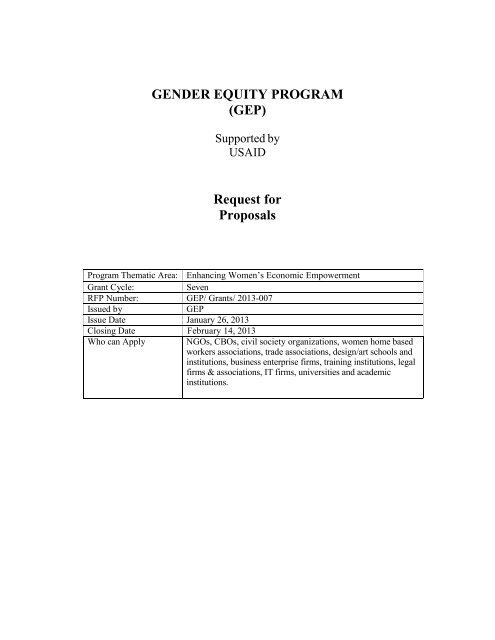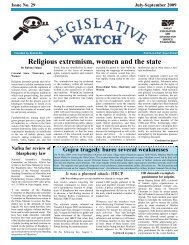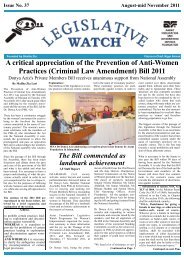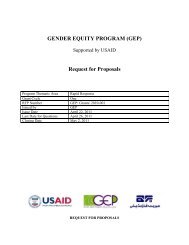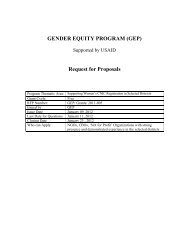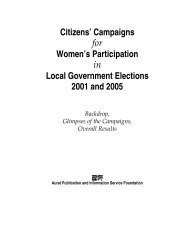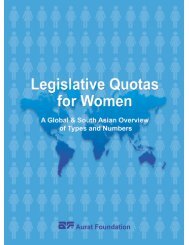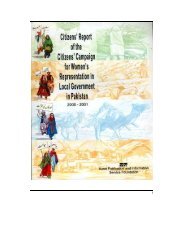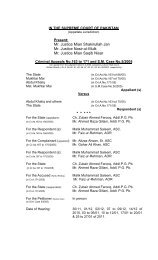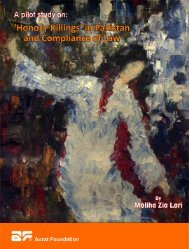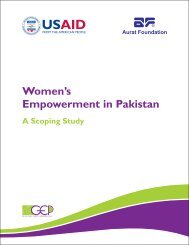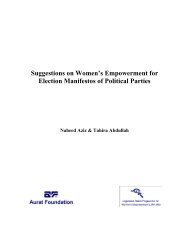GENDER EQUITY PROGRAM (GEP) Request for ... - Aurat Foundation
GENDER EQUITY PROGRAM (GEP) Request for ... - Aurat Foundation
GENDER EQUITY PROGRAM (GEP) Request for ... - Aurat Foundation
You also want an ePaper? Increase the reach of your titles
YUMPU automatically turns print PDFs into web optimized ePapers that Google loves.
<strong>GENDER</strong> <strong>EQUITY</strong> <strong>PROGRAM</strong>(<strong>GEP</strong>)Supported byUSAID<strong>Request</strong> <strong>for</strong>ProposalsProgram Thematic Area: Enhancing Women’s Economic EmpowermentGrant Cycle:SevenRFP Number: <strong>GEP</strong>/ Grants/ 2013-007Issued by<strong>GEP</strong>Issue Date January 26, 2013Closing Date February 14, 2013Who can Apply NGOs, CBOs, civil society organizations, women home basedworkers associations, trade associations, design/art schools andinstitutions, business enterprise firms, training institutions, legalfirms & associations, IT firms, universities and academicinstitutions.
REQUEST FOR PROPOSALSSUBJECT: <strong>Request</strong> <strong>for</strong> Proposals/RFP Number: <strong>GEP</strong>/ Grants / 2013 – 007Sub-Grants <strong>for</strong> Cycle Seven: Enhancing Women’s EconomicEmpowerment<strong>Aurat</strong> <strong>Foundation</strong> in collaboration with The Asia <strong>Foundation</strong> will award a series of sub-grants tolocal Pakistani organizations with the objective of affecting real behavioral change andcontributing to a productive gender debate within Pakistan. These grants are made possible withthe financial support of USAID under the Gender Equity Program (<strong>GEP</strong>). Various grant cycleswill be advertised over a five year period ending August 2015. The program is envisioned toimpact on a national level.<strong>Aurat</strong> <strong>Foundation</strong> invites and welcome the submission of proposals against the terms ofreference mentioned in Section Three of this RFP by registered civil society not-<strong>for</strong>-profitorganizations, private organizations, universities and training institutions among others.Frequently Asked Questions regarding <strong>GEP</strong> and/or the scope of work delineated in this RFP areavailable on the website. Completed proposals should be submitted via post (hardcopy) byclose of business on February 14, 2013 to the postal address given below.This RFP does not constitute a commitment to make an award on the part of <strong>GEP</strong> or any agencyimplementing or financing the project. The project will not pay <strong>for</strong> any cost(s) <strong>for</strong> the preparationor submission of proposals. <strong>GEP</strong> reserves the right to reject any or all proposals in the bestinterest of the project objectives.Grants Management CommitteeGender Equity Program (<strong>GEP</strong>)Email: info.gep@af.org.pkprocurement.gep@af.org.pkHouse 12, Street 12, F7/2, Islamabad 440002
ContentsSection 1: Summary In<strong>for</strong>mation .................................................................................................... 41.1 Vision and Goal .................................................................................................................... 41.2 Objectives/Priority Areas ...................................................................................................... 4Section 2: Sub-Grant In<strong>for</strong>mation................................................................................................... 52.1 Priority Area <strong>for</strong> Cycle Seven ............................................................................................... 52.2 Financial Allocation.............................................................................................................. 52.3 Closing Date.......................................................................................................................... 52.4 <strong>Request</strong>s <strong>for</strong> In<strong>for</strong>mation ...................................................................................................... 52.5 Award In<strong>for</strong>mation................................................................................................................ 5Section 3: Scope of Work ............................................................................................................... 63.1 Time Period........................................................................................................................... 63.2 Location................................................................................................................................................................ 63.3 Detailed Scope of Work <strong>for</strong> Cycle Two ............................................................................... 6Section 4: Baseline and Reporting ................................................................................................ 20Section 5: Proposal Process .......................................................................................................... 205.1 Who should apply ............................................................................................................... 205.2 Eligibility Criteria ............................................................................................................... 205.3 How to apply....................................................................................................................... 205.4 Sub-Grant Application Format ........................................................................................... 215.5 Evaluation Criteria……………………………………………………………………………………235.6 Award Criteria.................................................................................................................... ………245.7 Notification ......................................................................................................................... 24Section 6: Certifications................................................................................................................ 25ANNEX 1: Required Certifications .............................................................................................. 26ANNEX 2: Sample Work plan .................................................................................................... 35ANNEX 3: Sample Budget…………………………………………………………………………………...363
Section 1: Summary In<strong>for</strong>mationIn support of the Government of Pakistan's gender policies (National Plan of Action <strong>for</strong> Women,National Policy <strong>for</strong> Empowerment and Development of Women, and Gender Re<strong>for</strong>m ActionPlans) the <strong>Aurat</strong> <strong>Foundation</strong> (AF) and The Asia <strong>Foundation</strong> (TAF), with financial support fromUSAID, will implement a five year, Gender Equity Program (<strong>GEP</strong>). The program aims atadvancing women's human rights and empowerment. Under <strong>GEP</strong>, a series of sub-grants will beawarded to local Pakistani organizations with the objective of affecting real behavioral changeand contributing to a productive gender debate within Pakistan. The Program will work mainlythrough the award of approximately 400 sub-grants to local organizations over the course of fiveyears, and will mobilize local experience, expertise, and knowledge in pursuit of its Objectives.1.1 Vision and GoalThe vision of the Program is to generate widespread societal demand and commitment <strong>for</strong> asocially just, democratic, caring and gender-responsive society in Pakistan, where all citizens,women and men, are recognized as equal, with the right to lead their lives with self-respect anddignity. The goal of the Program will be to facilitate behavioral change: in particular to facilitatecitizens active participation in the process of social change and governance at all levels,enabling women to access in<strong>for</strong>mation, resources and institutions, acquire control over their livesand improve attitudes and behavior towards women and their concerns.1.2 Objectives/Priority Areas• Objective 1: Enhancing gender equity by expanding women’s access to justice andwomen’s human rights.• Objective 2: Increasing women’s empowerment by expanding knowledge of their rightsand opportunities to exercise their rights in the workplace, community, and home.• Objective 3: Combating Gender Based Violence (GBV)• Objective 4: Strengthening the capacity of Pakistani organizations that advocate <strong>for</strong>gender equity, women’s empowerment and the elimination of GBV.4
Section 2: Sub-Grant In<strong>for</strong>mation2.1 Priority Area <strong>for</strong> Cycle Seven<strong>GEP</strong>’s seventh grant cycle is in support of enhancing women’s economic empowerment acrossPakistan. Sub-grants on various themes are to be awarded to facilitate an enabling environment,ensure provision of required services, enhance skills and create opportunities aimed at improvingwomen’s livelihood options. An improvement in the identified services, skills and opportunitiesare to enable women’s choices, the right to exercise these and empower themselves through anexpansion of livelihood generation. These set of sub-grants will also demonstrate women’s roleand abilities to actively participate in, and contribute to, the economic progress of Pakistan whenprovided with equal opportunities.2.2 Financial Allocation<strong>GEP</strong> sub-grant awards will fall into three distinct tiers:• Below $25,000• $25,000 - $100,000• Over $100,000Tier 1 awards are expected to be most frequent. Tier 2 and Tier 3 sub-grant awards will be lesscommon. Individual ceilings will be allocated per sub-grant and will be detailed in the sub-grantsolicitations. All budgets will be subject to strict scrutiny to prevent excessive allocation.2.3 Closing DateThe final date <strong>for</strong> submission of the completed proposal application package and all requireddocuments is February 14, 2013. No extensions will be given.2.4 <strong>Request</strong>s <strong>for</strong> In<strong>for</strong>mationPlease note that verbal and telephonic requests will not be entertained. FAQs are posted on<strong>GEP</strong> webpage.2.5 Award In<strong>for</strong>mation1. Award TypeSimplified Grant or Fixed Obligation Grant (Simplified Grant Format (ADS 303.3.24))2. TimingThe review process <strong>for</strong> all sub-grants will take 6-8 weeks, following which all successfulapplicants will be contacted.5
Section 3: Scope of Work3.1 Time PeriodEach sub-grant has a suggested time period within which the project activities must becompleted.3.2 LocationApplicants are requested to mention their selected sub-grant number and location (districts)clearly in their applications.3.3 Detailed Scope of Work <strong>for</strong> Cycle SevenThe following section lists the sub-grants by thematic area and defines the conceptual design,location, budget, minimum suggested outputs and time period under each.1. Promoting improved livelihoods <strong>for</strong> in<strong>for</strong>mal sector workers (twelve sub-grants up to$40,000 each)Sub-grant 168: LahoreSub-grant 169: MultanSub-grant 170: SargodhaSub-grant 171: SialkotSub-grant 172: PeshawarSub-grant 173: HaripurSub-grant 174: SwatSub-grant 175: HyderabadSub-grant 176: KarachiSub-grant 177: QuettaSub-grant 178: MuzaffarabadSub-grant 179: SkarduA significant number of women are employed in the in<strong>for</strong>mal sector across Pakistan. While homebased work constitutes a critical opportunity <strong>for</strong> women to enable their incomes, the prevalentenvironment in which they function allows <strong>for</strong> limited empowerment. These twelve grants are insupport of greater organization, enhancement of craft/product and establishment of a direct accessto the market. The aims of these grants are to:• Mobilize home based workers, specifically craftswomen and artisans, <strong>for</strong> the <strong>for</strong>mation ofvillage-level groups/committees;• Work with the home based worker groups/committees to refine their existing skills andmake their products market-competitive (with input from an additional <strong>GEP</strong> partnerworking on product design and development);• Establish Trade Facilitation & Communication Centers (TFCC) at the district level to actas a marketing/sales/communication point <strong>for</strong> the home based workersThis sub-grant envisages an enhancement of women’s existing work, their skills and their craft toimprove their income generating abilities in the identified districts. It involves an initial mappingto identify the range of handicrafts and/or products being produced by women in these areas, and6
the related geographical hubs in which these are based. This would be followed up by ef<strong>for</strong>ts toorganize these women, where they remain unorganized, or to re-invigorate these groups wherethey have become stagnant or inactive. These groups are critical plat<strong>for</strong>ms to come together, shareexperiences, foster a culture of mutual learning and mobilize support mechanisms <strong>for</strong> home basedworkers. It will also provide an opportunity to rally these groups on their rights as well as linkthem with existing social security schemes. Given the contextual realities, such groups are to beorganized according to their distinct handicrafts/products.As part of this sub-grant an extensive skill development and product enhancement initiative willalso be undertaken. While the rolling out of the skill development sessions/workshops will be theresponsibility of the chosen sub-grantee, <strong>GEP</strong> is also soliciting the expertise of a design school oracademy under a separate sub-grant. This chosen partner will be working with the district-levelpartners to work on developing the identified crafts, innovating and making these market-relevant.The said partner will also be working on marketing these new/improved products to break out oftheir existing niche and cater to a wider and better paying audience.The sub-grant will also set up Trade Facilitation & Communication Centers (TFCC) that areexpected to be a long-term establishment catering to the ongoing needs of women home basedworkers. These can be an extension or enhancement of existing centers already being run by theapplicant organization. The TFCCs are expected to include a marketing space <strong>for</strong> display and saleof women’s improved products as well as facilitating linkages with potential buyers. Furthermore,these TFCCs will also function as women-friendly communication hubs, catering to the homebased workers as well as other women, where all the necessary In<strong>for</strong>mation and CommunicationTechnology (ICT) facilities are made readily available.Suggested time period: 12 monthsMinimum suggested outputs:• Identify groups of artisans and existing skill base in the chosen district• Women home based workers mobilized and organized into 6 village-levelgroups/committees, at a minimum covering two tehsils/talukas• 3 skill development workshops organized <strong>for</strong> each of the 6 village-levelgroups/committees, one per quarter• Coordination maintained, and support given to, the Product Development andMarketing sub-grant partner• Trial packs containing the required raw material distributed amongst the target women<strong>for</strong> improved product development• Linkages created with existing social security and benefit schemes• Database developed and maintained to track economic status of women workers• 1 Trade Facilitation & Communication Center established• District-level planning workshop organized bringing together the village-levelgroups/committees <strong>for</strong> next steps (post sub-grant life)Please note that the above are minimum requirements under this sub-grant. Preference will begiven to organizations with demonstrated previous experience and to proposals that containfurther innovation in the planned activities, while targeting a larger group of women.7
Who should apply?Home based women workers associations, trade associations, CBOs and NGOs based in theselected districts are encouraged to apply <strong>for</strong> this grant.2. Product development, refinement and facilitation of market integration (one sub-grantup to $100,000)Sub-grant 180: NationalPakistan’s home based workers and women artisans have a diverse skill base and produce avariety of handicrafts. Their skills, often passed down generations, <strong>for</strong>m the basis of theirlivelihoods and are the resource they rely upon <strong>for</strong> earning an income. While their existing skillbase provides a unique opportunity to enhance their incomes further and boost empowermentlevels, the demand <strong>for</strong> their craft and the monetary returns it offers is fast diminishing. There islittle professional guidance available to these women to bring innovation into their design,develop market-relevant products, improve the overall quality of their work, or successfullyintegrate their wares into a high-return market.Through this sub-grant ef<strong>for</strong>t to work with these women to bring innovation into their traditionalcrafts/products, facilitate development of value chains and optimize marketing opportunities, isbeing envisioned. The aims of this sub-grant are to:• Identify potential market opportunities <strong>for</strong> products based on traditional skills;• Design and develop a range of innovative products appealing to the identified markets;• Test, modify and refine the products until they are ready <strong>for</strong> production;• Work with women artisans to build their capacities on the new products, while enhancingtheir understanding of contemporary designs, color palettes and marketability;• Create linkages between the women artisans/ home based workers and the identifiedmarkets, and successfully integrate the new products into the identified market nichesThis sub-grant will work in close coordination with the district-level sub-grants outlined above(under 168-179). The existing skill base and range of products being developed in these districtswill be identified under 168-179. The successful applicant <strong>for</strong> this sub-grant will coordinate withthe district partners and pursue refinement and further development of the existing products.Suggested time period: 12 monthsMinimum suggested outputs:• Mapping exercise conducted to spot existing and upcoming market opportunities <strong>for</strong>the identified traditional arts and craft products• Sets of innovative products developed <strong>for</strong> each of the twelve districts• Facilitate skill development and product enhancement workshops organized under subgrants168-179 <strong>for</strong> the village-level home based workers groups/committees• Promote and leverage the new products in the identified markets8
• Integrate the products into the identified market opportunities and establish linkages ofwomen artisans to these facilities• Coordination meetings organized at the regional level, at grant opening and closingPlease note preference will be given to applicants with strong previous experience in productdesign and development, while demonstrating understanding of market trends and previoussuccess in market integration of products.Who should apply?Design schools/ institutions, art schools, training academies, business enterprise firms areencouraged to apply <strong>for</strong> this grant3. Enhancing women workers awareness on their rights and labor laws (seventeen subgrantsup to $35,000 each)Sub-grant 181: LahoreSub-grant 182: MultanSub-grant 183: FaisalabadSub-grant 184: SahiwalSub-grant 185: Rahim Yar KhanSub-grant 186: SialkotSub-grant 187: Karachi (Site area)Sub-grant 188: Karachi (Korangi Industrial Area)Sub-grant 189: HyderabadSub-grant 190: SukkurSub-grant 191: LasbelaSub-grant 192: PeshawarSub-grant 193: HaripurSub-grant 194: SkarduSub-grant 195: GilgitSub-grant 196: Islamabad Capital Territory (including Rawalpindi)Sub-grant 197: MirpurTwelve sub-grants will be awarded in the select districts across Pakistan to enhance awarenessamongst women workers around their rights and increase knowledge related to labor laws. Thesub-grants would focus on the districts which are existing industrial and/or other economicactivity hubs (<strong>for</strong>mal and in<strong>for</strong>mal) in the five provinces and aim to strengthen their ability as anin<strong>for</strong>med agency of change.These sub-grants seek to empower women workers by enhancing knowledge of their labor rights,and organize them into groups. This would include women workers from both <strong>for</strong>mal as well asin<strong>for</strong>mal sectors. As part of the sub-grant women workers will also be enabled to engage withemployers where applicable/possible.Through this initiative women factory/industrial workers, home based workers and daily wagewomen workers will be brought together on one plat<strong>for</strong>m – an innovative mechanism <strong>for</strong> their9
engagement. These grants will ensure that the district level context is kept in consideration whileselecting the women workers’ group. <strong>GEP</strong> will engage with another entity at the national level todesign and develop the training modules. This engagement will be supported by <strong>GEP</strong> through aseparate sub-grant. These modules will be utilized in workshops held across the provinces in allthe select districts, effectively raising awareness and understanding of women workers regardingtheir labor rights. Various sub-categories/industries where women are working would be targetedand the geographical spread of the workshops would correlate to the working women populationsplit in each region.Preference will be given to organizations that propose cost-effective options achieving thedeliverables under the sub-grants.Suggested time period: 12 monthsMinimum suggested outputs:• Context analysis of the select women workers’ groups based upon the district andprovincial scenarios• 5 training workshops held <strong>for</strong> women workers <strong>for</strong> 25-30 women workers in eachworkshop• One group of women workers’ (from <strong>for</strong>mal and in<strong>for</strong>mal sectors, both) representative is<strong>for</strong>med at the regional level and linkage of <strong>for</strong>mal sector women workers with the tradeunions• Vocation-specific and/or district/provincial <strong>for</strong>ums <strong>for</strong> women workers established and atleast three conventions held of these <strong>for</strong>ums• The employers (from <strong>for</strong>mal sector) are engaged to build their understanding on SexualHarassment Act and women friendly HR policies in place• Establish linkages between the women worker <strong>for</strong>ums and the provincial departments ofLaborWho should apply?NGOs, CBOs, advocacy groups and training institutions are encouraged to apply <strong>for</strong> this subgrant.4. Awareness-raising and policy advocacy on women’s rights and labor laws <strong>for</strong> womenworkers (one sub-grant up to $75,000)Sub-grant 198: NationalThis grant is to act as a coordinating body linked to the district-level advocacy grants outlinedabove. The sub-grant aims at:• Undertaking a thorough analysis of labor policies, women workers related legal provisionsand lacunas in the existing legislation regarding women working in <strong>for</strong>mal and in<strong>for</strong>malsector of the economy• Developing a module that encompasses concepts of women’s rights and labor laws(distinct in<strong>for</strong>mation as applicable to <strong>for</strong>mal vs. in<strong>for</strong>mal women workers)• Playing a coordination role <strong>for</strong> the district level sub-grantees10
• Arranging ToTs of the sub-grantees from select districts• Provincial and national level consultations with policy makers and parliamentarians toshare and discuss recommendations and enlist their support <strong>for</strong> the required amendmentsin the existing legislationUnder the sub-grant a specific module will be developed, encompassing concepts of women’srights and labor laws (regarding <strong>for</strong>mal and in<strong>for</strong>mal sectors both). The successful organizationwill be expected to undertake an extensive review work of the existing awareness-raising andlegal material, identify gaps and develop the module accordingly. The module would becustomized (reflective of provincial level labor laws) according to the ground realities of theparticular province in question.The training module would also cater to the needs of enhancing awareness of women workersgroups around the issues of women’s rights and labor laws. It is envisioned that a review ofexisting materials and modules will be conducted to identify gaps, and a consultative process willbe adapted to improve design. Focus group discussions may be held with women workers’groups, whereby draft recommendations are compiled by the moderator that later in<strong>for</strong>m trainingmodule content and design.The consultative process <strong>for</strong> module development, and a thorough analysis of labor policies andlaws, will enable the sub-grantee to come up with policy recommendations which will thenbecome the basis of extensive policy advocacy at the national/provincial level. The sub-granteewill coordinate with the district level sub-grantees to put <strong>for</strong>th collective demands in front of thepolicy makers at all levels.Suggested time period: 14 monthsMinimum suggested outputs:• Conduct analysis of existing labor laws and policies at provincial and national level• Hire services of a legal expert as the key resource• Develop and test a set of training module through a consultative process at the regionallevel• Organize a grants opening meeting <strong>for</strong> the district level sub-grantees (under sub-grants181-197 above), with participation of two persons per organization• Conduct Training of Trainers (ToTs) <strong>for</strong> the district level sub-grantees under sub-grants181-197 (it is expected that the ToTs be run in two batches <strong>for</strong> a duration of two days eachand a minimum of two staff members from each district level sub-grantee will participatein the ToT sessions)• Conduct provincial and national level seminars/consultations• Organize a grants closing meeting <strong>for</strong> the district level sub-grantees (under sub-grants181-197 above), with participation of two persons per organizationWho should apply?National level NGOs, advocacy groups, legal firms & associations and training institutions areencouraged to apply <strong>for</strong> this sub-grant.11
5. Advocacy campaign <strong>for</strong> Allocation and Rehabilitation of Women Friendly Spaces(twenty sub-grants between $25,000 - $60,000)Sub-grant 199: Muzaffarabad (up to $25,000)Sub-grant 200: Quetta (up to $30,000)Sub-grant 201: Sibbi (up to $25,000)Sub-grant 202: Lasbela (up to $25,000)Sub-grant 203: Skardu (up to $25,000)Sub-grant 204: Islamabad Capital Territory (including Rawalpindi) (up to $ 45,000)Sub-grant 205: Peshawar (up to $ 30,000 each)Sub-grant 206: Swat (up to $ 25,000 each)Sub-grant 207: Lahore (up to $45,000)Sub-grant 208: Multan (up to $30,000)Sub-grant 209: Faisalabad (up to $30,000)Sub-grant 210: Sialkot (up to $30,000)Sub-grant 211: Sahiwal & Sargodha (up to $45,000)Sub-grant 212: Rajan pur (up to $25,000)Sub-grant 213: Rahim Yar Khan (up to $25,000)Sub-grant 214: Muzaffargarh (up to $25,000)Sub-grant 215: Karachi (up to $60,000)Sub-grant 216: Hyderabad (up to $40,000)Sub-grant 217: Jacobabad & Sukkur (up to $45,000)Sub-grant 218: Benazirabad (up to $25,000)Sub-grants will be awarded to increase women’s empowerment by working towards creation ofwomen friendly environment facilitating their mobility and economic participation.The selected organizations are expected to design and undertake an advocacy campaign gearedtowards allocation and rehabilitation of toilets <strong>for</strong> women at private sector entities/industries thatemploy significant numbers of women and courts frequented by women in the designateddistricts. Furthermore, the sub-grant also envisions advocacy <strong>for</strong> establishment of day carefacilities at these private companies/industries and waiting areas <strong>for</strong> women in district courtpremises. The value addition through these inputs is expected to fill the gaps in the existingfacilities and services that hinder women in effectively accessing regular employment, theirretention and professional growth. Similarly, the intervention at the district courts level isexpected to provide an enabling environment <strong>for</strong> women to access the legal system.The first component of the sub-grants seeks to undertake advocacy ef<strong>for</strong>ts with employers rangingfrom mainstream private companies, industries as well as chambers of commerce in the selecteddistricts. The proposal should include a detailed advocacy plan and strategy which may include,but not limited to, the following activities:• Conducting a series of orientation sessions with existing employers at various tiers focusingon the importance of catering to the practical needs of women employees and providing amore conducive environment at the workplaces• Holding meetings to advocate <strong>for</strong> allotment of female toilets and setting up of day carefacilities• Developing and disseminating manuals laying out the guidelines <strong>for</strong> gender sensitive HRpolicies including Sexual Harassment Act so that women employees are able to work at12
their maximum potential• Developing and disseminating In<strong>for</strong>mation, Education and Communication (IEC) materialThe second component focuses on an advocacy campaign <strong>for</strong> the allocation of designated toiletsand private waiting areas <strong>for</strong> women in court premises at the district level. The campaign willtarget bar associations and councils in their independent capacity as representative bodies of thelawyers in the district.The organizations will be expected to submit a plan of action that details its engagement strategywith the bar associations/councils and the administrative units of district and high courts.Following a systematic approach, the selected organization will seek to establish aliaison/partnership with these elected bodies of lawyers by signing a memorandum ofunderstanding.The selected organization will work in tandem with bar associations and councils to seek theallotment of these toilets within the existing lavatories and waiting areas at court premises bydeveloping and disseminating messages and IEC material related to women friendly spaces withinthe court premises. Meetings with the designated people in the administrative units at the courtswill be held to roll the process <strong>for</strong>ward.Construction of new facilities does not come under the scope of this sub grant. However, minimalrehabilitation support maybe provided towards the uplifting of toilets based on an assessmentexercise. Similarly basic support may also be provided <strong>for</strong> setting up waiting areas.Suggested time period: 12 monthsMinimum suggested outputs:Advocacy with corporate sector entities:• Advocacy plan laying out the strategy and details of the campaign• At least 2 one-day workshops with the respective provincial chambers of commerce andindustries• At least 20 one-day workshops with mainstream private sector companies and industries inthe selected districts• Development and dissemination of detailed guidelines on gender-sensitive HR policies (inUrdu, English and Sindhi)• Development and dissemination plan <strong>for</strong> the IEC material• 10 success stories of corporate entities allocating space <strong>for</strong> day care facilities as a result of<strong>GEP</strong> engagement• 10 success stories of corporate entities/industries designating separate toilet facilities <strong>for</strong>womenAdvocacy with elected bodies of lawyers and administrative units within courts:• Memoranda of Understanding (MoU) with bar associations/counsels at district level• Advocacy plan laying out details of engagement with the elected bodies• Development and dissemination of detailed guidelines <strong>for</strong> gender-sensitive environment atthe district court premises13
• Development and dissemination of messages and IEC material related to women friendlyspaces within the court premises• Establishment of one waiting room <strong>for</strong> women in each district court• Rehabilitation of one toilet <strong>for</strong> women within the premises of each district courtWho should apply?For profit, as well as not-<strong>for</strong>-profit, organizations with prior experience working with the barassociations/councils, corporate sector and undertaking advocacy campaigns to promote womenrights are encouraged to apply <strong>for</strong> these sub-grants.6. Supporting female graduates access into In<strong>for</strong>mation Technology (IT) sectors throughinternship programs (ten sub-grants up to $75,000 each)Sub-grant 219: LahoreSub-grant 220: MultanSub-grant 221: FaisalabadSub-grant 222: KarachiSub-grant 223: HyderabadSub-grant 224: PeshawarSub-grant 225: Islamabad Capital Territory (including Rawalpindi)Sub-grant 226: MuzaffarabadSub-grant 227: MirpurSub-grant 228: GilgitIn<strong>for</strong>mation technology (IT) has traditionally remained an untapped sector <strong>for</strong> women. Thebarriers into this technical employment sector include lack of specialized training and access toentry points into the IT job market. However, given the huge market share in employment, thein<strong>for</strong>mation technology sector offers huge employment potential <strong>for</strong> women. To this end, <strong>GEP</strong>envisions support to women having fresh graduate degrees by providing specialized training andinternship placements. The value addition through these inputs is expected to capacitate women,provide relevant entry points into the job market as well as the exposure that will increase theirchances of finding long-term employment in the sector.The selected organizations will be expected to:• Conduct a detailed need assessment and identification of the required IT skills to build thecapacity of women graduates and enhance their chances of employability• Conduct a mapping and selection of women beneficiaries (fresh graduate) from ITdepartments of universities• Mapping of corporate sector entities where women can be placed on internships <strong>for</strong> aperiod of 6-months• Advocacy regarding the establishment of women friendly environment, sexual harassmentat work places, gender sensitization and laws on women protection will be initiated in theselected companies where the internees are placed• Develop and pre-test training material based on the identified needs• Hire services of consultant in close consultation with <strong>GEP</strong> team, to develop/comprehend amanual from the already developed contents under <strong>GEP</strong>, used to impart the awareness14
aising training with detailed guidelines <strong>for</strong> delivery of training on Sexual Harassment Act,labor laws, women friendly spaces etc.• Arrange placement in companies of women <strong>for</strong> 6 months internships, with a smallmonthly stipend. This learning opportunity is likely to increase their employment choicesand provide linkages to fresh women graduatesIt is hoped that the internees will serve as agents of change by initiating, advocacy regarding theestablishment of women friendly environment, sexual harassment at work places, gendersensitization and laws on women protection in the selected companies where the internees areplaced.Potential Organizations applying <strong>for</strong> this sub-grant must identify in each province the districthaving the various Public/ private universities graduates that they propose <strong>for</strong> partnership andpotential industries/firms <strong>for</strong> placement.Suggested time period: 12 monthsMinimum suggested outputs:• Conduct baseline in the first 1.5 month with the scope including, identification ofemployable IT skills, identification of potential companies where internees can be placed,Mapping and selection of women beneficiaries (fresh graduates) from IT departments ofuniversities and recommendations on skills on which women internees should be trained• Hire services of a gender expert as the key resource <strong>for</strong> design and delivery of trainingmanual (from content already under <strong>GEP</strong>) on Sexual Harassment Act, labor laws,promoting women friendly spaces• Develop and pre-test training modules on IT employable skills• Deliver four specialized trainings <strong>for</strong> the trainee graduates (each training consisting of aminimum 30 participants <strong>for</strong> the duration of 3 weeks)• Conduct four training workshops on women’s rights, labor laws, Sexual Harassment Actand promotion of women friendly spaces (each training will consist of a minimum of 30participants and will be <strong>for</strong> a duration of 3 days)• Conduct seven workshops (one in each city) with employers to orient them to womenfriendly workplaces, labor laws and Sexual Harassment Act• Develop and maintain a database to keep track of the internees and their employmentstatus• 120 IT women graduates placed on internships with entities <strong>for</strong> six monthsWho should apply?IT firms, academic & training institutions and NGOs are encouraged to apply <strong>for</strong> this grant.7. Training of sub-grantees on Project Cycle Management (PCM) and FinancialManagement (FM), Gender sensitization and women friendly laws (one sub-grant up to$150,000)Sub-Grant 229: NationalThis sub-grant aims to build the capacity of <strong>GEP</strong> sub-grant recipients through executing agreed15
number of learning interventions focusing on: 1) Project Cycle Management, 2) FinancialManagement, 3) Gender sensitization and women friendly laws. The trainings/workshops will bedesigned with an objective to introduce, improve and enhance <strong>GEP</strong> sub-grantees understanding ofkey principles of Project Cycle Management (PCM) and Financial Management (FM) concepts aswell as enhance their awareness and knowledge of new legislation in the context of women. Thiswill enable the sub grantees in taking an initiative to incorporate these laws in their respectivehuman resource policies. The learning interventions propose to address the above modules ingeneral and will particularly focus on <strong>GEP</strong> specific project management including financialmanagement.More specifically, this grant aims to improve the capacity of grant recipients in:• Understanding all aspects of Project Management Cycle and Financial Management;• Enabling grant recipients to improve their efficiency in their day to day management ofproject activities; beginning from project identification including monitoring, evaluation,reporting to final assessment when the project ends. Similarly, enabling the grantrecipients to manage and fulfill their respective financial management ensuring efficiencyunder the <strong>GEP</strong> project grants in particular and that of others in general;• Develop Project Reporting System; ensuring timely systems implementation monitoringand evaluation of project activities;• Develop Project Finance Procedures; ensuring a viable and transparent use of <strong>GEP</strong> subgrants.• Reporting and documentation of project activities in line with <strong>GEP</strong> requirements onagreed <strong>for</strong>mats and agreed report submission timeline;• Understand and integrate women friendly laws in their human resource policies andadvocate organizational staff accordingly.Key strategies to be followed by the awardees <strong>for</strong> implementing grant (are not limited to) mayinclude:• Design and conduct training workshops across four provinces including Gilgit Baltistan(GB) and AJK at central locations• Ensure workshop participants to be <strong>GEP</strong> grantees with a view to develop their capacityand knowledge in PCM, FM and women friendly laws• Encompass local environment context while designing and delivering training workshops• Incorporate an interactive and integrated learning approach (including use ofpresentations, group exercises, individual activities, brainstorming, experience sharing andother methods) to retain participants engagement and interest ensuring continuedparticipants’ learning• Keep Urdu primarily as a medium of instruction , along with local languages, especiallySindhi, where necessary• Develop an effective learning intervention assessment tool to monitor and measure theefficacy of each learning event• The pre assessment of workshop participants must be carried out at a reasonable time togather participant in<strong>for</strong>mation prior to the event• Carry out participant feedback to enable immediate appraisal of the learning interventionSuggested time period: 12 months16
Minimum suggested outputs:• Recruit a consultant with significant involvement of <strong>GEP</strong> capacity building unit totranslate <strong>GEP</strong> modules of PCM and FM into Urdu to further enhance the impact oftraining workshops• Consultant to develop a training module on gender sensitization and pro women lawstrainings in close coordination with the capacity building unit at <strong>GEP</strong> with the help of thematerial provided by <strong>GEP</strong>• Conduct 5 days training; focusing on 2 days on PCM, 2 days on FM and 1 day on womenfriendly laws at centrally located sites across four provinces of Pakistan includingGilgit/Baltistan (GB) and Azad Jammu and Kashmir (AJK)• A total of approximately 180 participants trained on PCM/FM/gender sensitization andwomen friendly laws practices in 9 workshops. Each workshop to have a minimum of 20participants• Consolidated report of all 9 workshops with pictures, details of sessions, tabulatedevaluations and outcomes along with the pre and post training assessment andparticipants’ feedback analysis <strong>for</strong> all three modules• Monitoring and evaluation systems developed and approved <strong>for</strong> all workshops two weeksprior to the workshop• Training calendar, administrative and logistical arrangements of all workshops to befinalized and shared with grant holder a week be<strong>for</strong>e the planned workshop• Develop participants workshop feedback as well as a pre and post training evaluation toolin close coordination with the Capacity Building Unit of <strong>GEP</strong>• Develop an Impact Assessment Tool in close coordination with capacity building unit at<strong>GEP</strong> to ensure quality and impact of all learning events, adhering to a timelines.• Conduct detailed post training impact assessment and share the draft as well as the finalreport with <strong>GEP</strong>Who should apply?NGOs, universities/academic institutions, firms and training institutions having a minimum offive years of relevant experience are encouraged to apply <strong>for</strong> this sub-grant.8. Innovative approaches to promoting women’s economic empowerment (ten sub-grantsup to $25,000 each)Sub-grant 230-239: NationwideTen ‘open ended’ sub-grants will be awarded to support initiatives that facilitate women’seconomic empowerment through innovative, sustainable and creative ways. These sub-grants arenot bound to specific geographical locations or outline defined activity/output expectations. Theinterested organizations are encouraged to submit applications that propose localized, contextspecific,innovative and sustainable solutions to women’s economic empowerment concerns intheir chosen areas of implementation. Successful applicants will be the ones able to demonstrateprior experience with the proposed initiative, and that this has been able to achieve demonstrablesustainable solutions to women’s economic empowerment concerns.17
The Gender Equity Program supports the understanding that women’s economic empowermentwill be achieved by expanding women’s economic opportunity, strengthening their legal statusand rights, and ensuring their voice, inclusion and participation in economic decision-making.There are a number of mechanisms through which women’s economic empowerment can befacilitated – and the interested applicants are invited to propose any initiative that falls under anyof these key ambits:• Expansion of women’s economic opportunities across a wide range of sectors;• Supporting a business endeavor that facilitates women to start, as well as grow, theirenterprises;• Enhancement of women’s management and entrepreneurial skills;• Development and/or enhancement of localized employment opportunities <strong>for</strong> women;• Facilitating a financial environment where women are able to access credit and savingsschemes tailored to their needs;• Supporting greater livelihood and food security <strong>for</strong> women, especially in rural areas andvulnerable environments;• Securing women’s legal rights, especially related to land, physical assets and inheritance,as an indispensable component of their empowerment and a prerequisite <strong>for</strong> pursuingeconomic activity;• Supporting women’s voices to be heard in the economic arena.Who should apply?Organizations with prior working experience, and the ability to demonstrate successful results,related to women economic empowerment initiatives (both profit and non-profit sectors) areencouraged to apply <strong>for</strong> these sub-grants.Section 4: ReportingThe proposal must also include a detailed monitoring and reporting plan outlining output andoutcome indicators (disaggregated by gender) which the proposal seeks to affect <strong>for</strong> allactivities listed. The reporting plan must include a quarterly progress report and a projectcompletion report. If the project proposal is accepted the sub-grantee will be required tofinalize the reporting indicators and timelines with the Monitoring and Evaluation section of<strong>GEP</strong>.Section 5: Proposal Process5.1 Who should applyThe following types of organizations should apply <strong>for</strong> the sub-grants in thissolicitation:• NGOs, CBOs, civil society organizations, women home based workersassociations, trade associations, design/art schools and institutions, businessenterprise firms, training institutions, legal firms & associations, IT firms,universities and academic institutions.18
5.2 Eligibility Criteria1. The organization shall be registered in Pakistan2. The organization shall have a track record in the sector3. The organization should be based in the target area or have a strong capacity <strong>for</strong>outreach in the target area and target sector4. The organization shall demonstrate financial accountability, preferably audited accounts.5.3 How to applyProspective sub-grantees should submit a completed application package; the proposal <strong>for</strong>mand budget template available in this document. A complete application should include:1. <strong>GEP</strong> Proposal Application Form (Section 5.4)2. Work Plan (Annex 2)3. Proposal Budget (Annex 3)4. Reporting plan including a proposal <strong>for</strong> a baseline study to define key indicators5. CVs of 3 key staff members6. Financial audit report <strong>for</strong> the past 3 fiscal years if available7. Copy of Registration8. Signed and stamped certifications (Available in Annexes)a. Certification Regarding Terrorist Financingb. Narcotics offenses and drug trafficking- key individualcertificationc. Narcotics offenses and drug trafficking - participantcertificationd. Certification regarding debarment, suspension, ineligibility and voluntaryexclusion lower tier covered transactionse. Voluntary Population Planning activitiesf. Initial Environmental ExaminationApplications should be submitted in hardcopy. Incomplete applications may berejected. Applications sent after the last date may also be rejected.Please address your applications to: Grants Management CommitteeGender Equity Program(<strong>GEP</strong>) House 12, Street 12,F-7/2,Islamabadprocurement.gep@af.org.pk19
5.4 Sub-Grant Application FormatInstructions:1. Please copy sections A-C below and complete in a new Word document. Section D-Etemplates are available in the annexes2. Application <strong>for</strong>ms (Sections A-C) may NOT exceed 10 pages in length. Please use TimesNew Roman, Font size 123. In Sections D and E, please add rows as necessary depending on your proposed activities.Section A: Introductory In<strong>for</strong>mation (Cover Sheet)1. Name and Contact In<strong>for</strong>mation of Organization2. Sub-Grant Title/Number3. Estimated Start/End Dates of the Project4. Total Project CostSection B: Organizational Profile1. Full legal name and acronym:2.3.4.5.6.7.Legal status (type of registration e.g. government body, non-governmentalorganization, limited liability company, partnership, etc, registration number) &date of registration of organization:Type of organization (e.g. service delivery, advocacy, research, educational,other):Organization’s outreach (local, provincial, national, and whether urban and/orrural):Number of offices and appropriate staff strength:Publications:Previous Donors (i.e. names of organizations or bodies from which the applicanthas received any type of funding):20
Previous similar donor-funded projects undertaken in the past 3 years:8.9.10.Project Name & Location:Project Description (2-3 lines):Donor Name:Project Duration, i.e. start/end date:Contact Person/Designation:Email address:Contact Number:Note: Please provide above details <strong>for</strong> all previous projects.Members of organizations Board (if any):Other partners (organizations with which the applicant has collaborated over thelast three years. Please indicate nature of links e.g. program implementation,in<strong>for</strong>mation sharing, technical training etc):11. Official street address, telephone, fax and email:Section C: About the Grant1. Grant title:2. Grant goals/objectives:3. Grant rationale (description of why the project has been proposed, and a shortanalysis of the problem it is tackling):4. Expected impact of the grant:5. Target group (number and description of direct and indirect beneficiaries, how theywill benefit from the grant and be involved in the project cycle):6. Grant location and duration:7. Methodology (description of the approach, tools and techniques <strong>for</strong>implementing the activity):8. Key activities and description, including outputs/deliverables and indicators beingused:9. Implementation plan and schedule (please attach):21
10. Personnel (details of proposed roles and responsibilities of key staff):Name:Proposed designation/responsibilities:Previous relevant experience:11.Linkages (with existing or previous work done, indicating the impact of thatactivity and details of any other opportunities <strong>for</strong> developing local or nationallinkages:12. Grant partners (other organizations that will be involved in the grant and theirrole:13. Other donors (donors who are either currently funding work related to this grantapplication or who have been approached <strong>for</strong> funding <strong>for</strong> the same grant:14. Monitoring & Evaluation Plan and reporting schedule (please attach):15. Publicity (plans <strong>for</strong> highlighting the interventions planned <strong>for</strong> the grant):16. Sustainability (attach your plans <strong>for</strong> sustainability of grant outputs:17. Total grant funding requested in Pak Rupees (attach a breakdown of thisamount, indicating which costs, if any, will be covered by the applicant and/orother identified sources):Section D: Project Work PlanA sample work plan is available in Annex 2.22
Section E: Grant BudgetThe detailed budget is available in Annex 3.5.5 Evaluation CriteriaAll proposals will go through a stringent review process. The first will ensure that allapplications are complete with:1. Completed application <strong>for</strong>m with the relevant signatures/stamps2. The completed package is sent be<strong>for</strong>e the final deadline3. All supporting documents are presentProposals meeting the eligibility criteria will undergo reviews by the Grants ManagementCommittee (GMC). Sub-grants will be made with a view to those projects deemed most likely tomeet <strong>GEP</strong> objectives.5.6 Award CriteriaAll applications will be reviewed under the following standardized criteria:1. Previous Relevant Experience (30)2. Technical Proposal (30)3. Financial Proposal (20)4. CVs of core staff proposed on the project (20)5.7 NotificationAll applicants will receive notifications regarding the status of their proposals. Letters of regretwill be sent out <strong>for</strong> all proposals that <strong>GEP</strong> will not be able to assist in this cycle. Notificationswill include reasons <strong>for</strong> regret, encouragement to re-apply in future cycles, and/or referrals to<strong>GEP</strong>‟s capacity building workshops.Finalized applicants will be notified in writing as well as by telephone. The notification willmake clear that the sub-grant is pending on adequate results of the pre-award evaluation and finalapproval by USAID.23
Section 6: CertificationsThe following certifications must be signed, stamped and submitted along with your application.1. Certification Regarding Terrorist Financing2. Narcotics offenses and drug trafficking- key individual certification3. Narcotics offenses and drug trafficking - participant certification4. Certification regarding debarment, suspension, ineligibility and voluntary exclusionlower tier covered transactions5. Voluntary Population Planning activities6. Environmental Impact AssessmentAll certifications are available in Annex 124
ANNEX 1: Required Certifications(1)Certification Regarding Terrorist Financing Implementing E.O. 13224USAID requires that recipients sign the certification below as a prerequisite to receiving a grant from a U.S.Government source.CERTIFICATION REGARDING TERRORIST FINANCING IMPLEMENTING E.O. 13224By signing and submitting this application, the prospective recipient provides the certification set out below:1. The Recipient has not provided, and will take all reasonable steps to ensure that it does not and willnot knowingly provide, material support or resources to any individual or entity that commits,attempts to commit, advocates, facilitates, or participates in terrorist acts, or has committed, attemptedto commit, facilitated, or participated in terrorist acts.2. Specifically, in order to comply with its obligations under paragraph 1, the Recipient will take thefollowing steps:a. Be<strong>for</strong>e providing any material support or resources to an individual or entity, the Recipientwill verify that the individual or entity does not appear on the master list of SpeciallyDesignated Nationals and Blocked Persons, which list is maintained by the U.S. Treasury’sOffice of Foreign Assets Control (OFAC) and is available online at OFAC‟s website :http://www.treas.gov/offices/eotffc/ofac/sdn/t11sdn.pdf , or (ii) on any supplementary list ofprohibited individuals or entities that may be provided by USAID to the Recipient. TheRecipient also will verify that the individual or entity has not been designated by the UnitedNations Security (UNSC) sanctions committee established under UNSC Resolution 1267(1999) (the ì1267 Committee) [individuals and entities linked to the Taliban, Osama binLaden, or the Al Qaida Organization]. To determine whether there has been a publisheddesignation of an individual or entity by the 1267 Committee, the Recipient should refer tothe consolidated list available online at the Committee’s website:http://www.un.org/Docs/sc/committees/1267/1267ListEng.htm .b. Be<strong>for</strong>e providing any material support or resources to an individual or entity, the Recipientwill consider all in<strong>for</strong>mation about that individual or entity of which it is aware or that isavailable to the public.c. The Recipient will implement reasonable monitoring and oversight procedures to safeguardagainst assistance being diverted to support terrorist activity.3. For purposes of this Certificationa.Material support and resources means currency or monetary instruments or financialsecurities, financial services, lodging, training, expert advice or assistance, safe houses, falsedocumentation or identification, communications equipment, facilities, weapons, lethalsubstances, explosives, personnel, transportation, and other physical assets, except medicineor religious materials.b. Terrorist act meansi.an act prohibited pursuant to one of the 12 United Nations Conventions andProtocols related to terrorism (see UN terrorism conventions Internet site:http://untreaty.un.org/English/Terrorism.asp ); or25
ii. an act of premeditated, politically motivated violence perpetrated againstnoncombatant targets by sub national groups or clandestine agents; oriii. any other act intended to cause death or serious bodily injury to a civilian, or to anyother person not taking an active part in hostilities in a situation of armed conflict,when the purpose of such act, by its nature or context, is to intimidate a population,or to compel a government or an international organization to do or to abstain fromdoing any act.c. Entity means a partnership, association, corporation, or other organization, group orsubgroup.This Certification is an express term and condition of any agreement issued as a result of this application, andany violation of it shall be grounds <strong>for</strong> unilateral termination of the agreement by USAID prior to the end of itsterm.APPLICANT:Name:Signature:Title:Date:26
I hereby certify that within the last ten years:(2)KEY INDIVIDUAL CERTIFICATION NARCOTICSOFFENSES AND DRUG TRAFFICKING1. I have not been convicted of a violation of, or a conspiracy to violate, any law or regulation of theUnited States or any other country concerning narcotic or psychotropic drugs or other controlledsubstances.2. I am not and have not been an illicit trafficker in any such drug or controlled substance.3. I am not and have not been a knowing assistor, abettor, conspirator, or colluder with others in theillicit trafficking in any such drug or substance.Signature:Date:Name:Title/Position:Organization:Address:Date of Birth:NOTICE:1. You are required to sign this Certification under the provisions of 22 CFR Part 140, Prohibition onAssistance to Drug Traffickers. These regulations were issued by the Department of State and requirethat certain key individuals of organizations must sign this Certification.2. If you make a false Certification you are subject to U.S. criminal prosecution under 18 U.S.C. 1001.27
1. I hereby certify that within the last ten years:(3)PARTICIPANT CERTIFICATION NARCOTICSOFFENSES AND DRUG TRAFFICKINGa. I have not been convicted of a violation of, or a conspiracy to violate, any law or regulation ofthe United States or any other country concerning narcotic or psychotropic drugs or othercontrolled substances.b. I am not and have not been an illicit trafficker in any such drug or controlled substance.c. I am not or have not been a knowing assistor, abettor, conspirator, or colluder with others inthe illicit trafficking in any such drug or substance.2. I understand that USAID may terminate my sub-grant if it is determined that I engaged in the aboveconduct during the last ten years or during my USAID training.Signature:Name:Date:Address:Date of Birth:NOTICE:1. You are required to sign this Certification under the provisions of 22 CFR Part 140, Prohibition onAssistance to Drug Traffickers. These regulations were issued by the Department of State and requirethat certain participants must sign this Certification.2. If you make a false Certification you are subject to U.S. criminal prosecution under 18 U.S.C. 1001.28
(4)Certification Regarding Debarment, Suspension, Ineligibility and Voluntary ExclusionLower Tier Covered Transactions(a) Instructions <strong>for</strong> Certification1. By signing and submitting this proposal, the prospective lower tier participant is providing thecertification set out below.2. The certification in this clause is a material representation of fact upon which reliance was placedwhen this transaction was entered into. If it is later determined that the prospective lower tierparticipant knowingly rendered an erroneous certification, in addition to other remedies available tothe Federal Government, the department or agency with which this transaction originated may pursueavailable remedies, including suspension and/or debarment.3. The prospective lower tier participant shall provide immediate written notice to the person to whomthis proposal is submitted if at any time the prospective lower tier participant learns that itscertification was erroneous when submitted or has become erroneous by reason of changedcircumstances.4. The terms "covered transaction," "debarred," "suspended," ineligible, "lower tier covered transaction,""participant," "person," "primary covered transaction," "principal," "proposal," and "voluntarilyexcluded," as used in this clause, has the meanings set out in the Definitions and Coverage sections ofrules implementing Executive Order 12549. 1/ You may contact the person to which this proposal issubmitted <strong>for</strong> assistance in obtaining a copy of those regulations.5. The prospective lower tier participant agrees by submitting this proposal that, should the proposedcovered transaction be entered into, it shall not knowingly enter into any lower tier coveredtransaction with a person who is debarred, suspended, declared ineligible, or voluntarily excludedfrom participation in this covered transaction, unless authorized by the department or agency withwhich this transaction originated.6. The prospective lower tier participant further agrees by submitting this proposal that it will includethis clause titled "Certification Regarding Debarment, Suspension, Ineligibility and VoluntaryExclusion--Lower Tier covered Transaction," 2/ without modification, in all lower tier coveredtransactions and in all solicitations <strong>for</strong> lower tier covered transactions.7. A participant in a covered transaction may rely upon a certification of a prospective participant in alower tier covered transaction that it is not debarred, suspended, ineligible, or voluntarily excludedfrom the covered transaction, unless it knows that the certification is erroneous. A participant maydecide the method and frequency by which it determines the eligibility of its principals. Eachparticipant may, but is not required to, check the Non procurement List.8. Nothing contained in the <strong>for</strong>egoing shall be construed to require establishment of a system of recordsin order to render in good faith the certification required by this clause. The knowledge andin<strong>for</strong>mation of a participant is not required to exceed that which is normally possessed by a prudentperson in the ordinary course of business dealings.9. Except <strong>for</strong> transactions authorized under paragraph 5 of these instructions, if a participant in a coveredtransaction knowingly enters into a lower tier covered transaction with a person who is suspended,debarred, ineligible, or voluntarily excluded from participation in this transaction, in addition to other29
emedies available to the Federal Government, the department or agency with which this transactionoriginated may pursue available remedies, including suspension and/or debarment.1/ See ADS Chapter 303, 22 CFR 208.2/ For USAID, this clause is entitled "Debarment, Suspension, Ineligibility, and Voluntary Exclusion(March 1989)" and is set <strong>for</strong>th in the USAID grant standard provision <strong>for</strong> U.S. nongovernmentalorganizations entitled "Debarment, Suspension, and Related Matters" (see ADS Chapter 303), or inthe USAID grant standard provision <strong>for</strong> non-U.S. nongovernmental organizations entitled"Debarment, Suspension, and Other Responsibility Matters" (see ADS Chapter 303).(b) Certification Regarding Debarment, Suspension, Ineligibility and Voluntary Exclusion--Lower TierCovered Transactions1. The prospective lower tier participant certifies, by submission of this proposal, that neither it nor itsprincipals is presently debarred, suspended, proposed <strong>for</strong> debarment, declared ineligible, or voluntarilyexcluded from participation in this transaction by any Federal department or agency.2. Where the prospective lower tier participant is unable to certify to any of the statements in thiscertification, such prospective participant shall attach an explanation to this proposal.Application Title:Date of Application/Proposal:Name of Recipient:Typed Name and Title:Signature/Date20
(5)752,7101 VOLUNTARY POPULATION PLANNING ACTIVITIES. (JUNE 2008)(a) Requirements <strong>for</strong> voluntary sterilization programNone of the funds made available under this contract shall be used to pay <strong>for</strong> the per<strong>for</strong>mance ofinvoluntary sterilizations as a method of family planning or to coerce or provide and financialincentive to any individual to practice sterilization.(b) Prohibition on abortion-related activities1. No funds made available under this contract will be used to finance, support, or be attributed tothe following activities:a. Procurement or distribution of equipment intended to be used <strong>for</strong> the purpose of inducingabortions as a method of family planningb. Special fees or incentives to any person to coerce or motivate them to have abortionsc. Payments to persons to per<strong>for</strong>m abortions or to solicit persons to undergo abortionsd. In<strong>for</strong>mation, education, training, or communication programs that seek to promoteabortions as a method of family planning; ande. Lobbying <strong>for</strong> or against abortion. The term Ñmotivate‟ as it relates to family planningassistance, shall not be construed to prohibit the provision, consistent with local law, ofin<strong>for</strong>mation or counseling about all pregnancy options.2. No funds made available under this contract will be used to pay <strong>for</strong> any biomedical researchwhich relates, in whole or in part, to methods of, or the per<strong>for</strong>mance of, abortion or involuntarysterilizations as a means of family planning. Epidemiologic or descriptive research to assess theincidence, extent or consequences of abortions is not precluded.Name & TitleSignatureDate21
(6)Initial Environmental Examination FormGender Equity ProgramGrant # , (Grant Title)A. Applicant in<strong>for</strong>mationContractor/grantee(organization)Individual contactand titleActivity (briefdescription)Address, phoneand email(if available)AmountLocation of activityStart and end dateof activityB. Activities, screening results, and recommended determinationTABLE 1Proposed Sub-activitiesScreening result(Step 3 of instructions)Very Low RiskModerate RiskHigh RiskRecommended Determinations(Step 6 of instructions. Complete<strong>for</strong> all moderate and high-riskactivities)No significantadverse impactWith specifiedmitigation, nosignificantadverse impact,SignificantAdverseimpact22
C. Summaryof recommendedd determinationsThe activity contains. . .Very low risk sub-activitiesAfter environmental review, sub-activities determined tohave nosignificant adverse impactsAfter environmental review, sub-activities determined tohave nosignificant adverse impacts, given appropriatemitigation and monitoringAfter environmental review, sub-activities determined tohave significant adverse impacts(equivalent regulation 2166 terminology)categorical exclusion(s)negative determination(s) )negative determination(s) ) with conditionspositive determination(s)D. Certification:I, the undersigned, certifythat:1. The in<strong>for</strong>mation on this <strong>for</strong>m is correct and complete2. The following actions have been and will be taken to assuree that the activity complies with environmentalrequirements <strong>for</strong> the (Project name) under the Code of Federal Regulations 22 CFR 216:• T hese design elements and best practices willl be followed inn implementing this activity, except with theapproval of USAID.• Any specific mitigation or monitoring measures described inn the attached in<strong>for</strong>mation will be implementedintheir entirety.• Compliance withthese conditions will be regularly confirmed and documented by on-site inspectionsduring the activity and at its completion.SignatureDateBELOWTHIS LINE FOR USAID USE ONLYApprovalUSAID Project Officer Approved RejectedUSAID MEOor DMEO Approved Rejected(print name)(print name)(signature)(signature)USAID comments: (if documentation is rejected, comments must be provided to applicant23
ANNEX 2: Sample Work plan1 Project name2 Organization3 Grant NoQuarter 1 Quarter 2 Quarter 3 Quarter4ID Task Activity QTY Time Jan Feb Mar Apr May Jun Jul1 (no.) (days)2345678910111235
ANNEX 3: Sample BudgetName of Organization:Project Name:Sub - grant No:
Line ItemsDescriptionUnitCostRs.Numberof UnitsUnitAnticipated InstallmentsQuarter 1 Quarter 2 *1.0 Personnel Cost(Rs. 15,000 x 1 person x 61.1 e.g. Program Coordinator1 Monthmonths) 15,00045,000 45,000 90(Rs. 10,000 x 2 persons x 61.2 e.g. Social Mobilizer2 Monthmonths) 10,00060,000 60,000 121.3 - -2.0 Program Activities Cost2.1 e.g. Activity 1 Base line Survey (Rs. 45,000 x 1)45,0001 EventSubtotal 105,000 105,00045,000 - 452.2 e.g. Activity 2 Field Monitoring (Rs. 1,000 x 60 visits)60 Visit1,00030,000 30,000 60e.g. Activity 3 Other Program (Activity cost x Number of2.32 ActivityActivitiesActivities) 500,000500,000 500,000 1,2.4 - -3.0 Administrative Cost (If any)Subtotal 575,000 530,000 1(e.g. Courier charges, Telephone3.1 e.g. Communication1 Monthand Internet) 1,0003,000 3,000 6,3.2 e.g. Stationery (e.g. Project Documentation) 500 1 Month 1,500 1,5003.3 - -Subtotal 4,500 4,500GRAND TOTAL 684,500 639,5001*Increase columns asnecessary to addquarters and rows toadd program activitiesNote: The above is a sample budget and only <strong>for</strong>guidance. The above figures are not actual <strong>for</strong> anybudgeting purposes.


